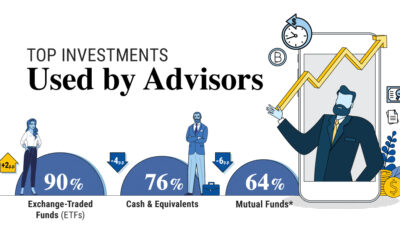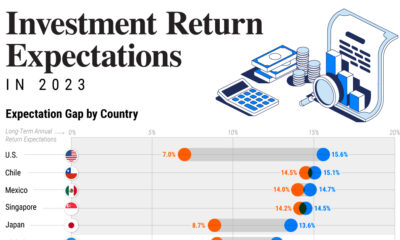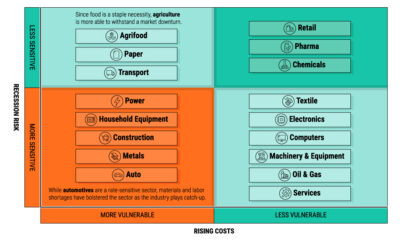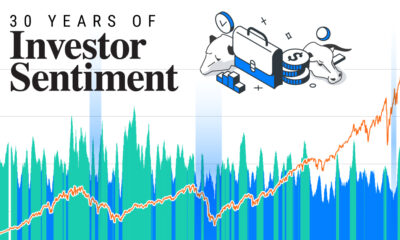This infographic is available as a poster.
Visualizing Housing Prices and Inflation
Do housing prices feed into inflation?
Often, rising housing prices lead to higher rents, and rent contributes to inflation. In fact, shelter makes up over 30% of the consumer price index (CPI), a common inflation measure.
Still, the relationship is not 1:1. Historical data has shown a lag between housing prices and the CPI, while other factors—such as input prices and demand—impact their relationship.
This Markets in a Minute from New York Life Investments charts housing prices and inflation over the last 30 years.
Housing Prices and Inflation in Context
In the first quarter of 2022, U.S. housing prices rose at the fastest rate in over three decades—jumping over 18% in the last year.
Not only that, housing price growth has been at a double-digit annualized pace for each of the last six quarters, going back to Q4 2020.
Rising construction input costs have been a key factor. Combined labor and material costs increased 3% in 2019, in the line with the historical average. By 2021, these costs increased 10%, driven by supply-chain disruptions. Low interest rates also boosted demand.
Below we look at the 20 highest annual changes in the price index by quarter since 1992. Data is based on the Federal Housing Finance Agency’s House Price Index.
| Rank | Year | Quarter | Housing Price Index Change
(Previous 4 Quarters) |
| 1 | 2022 | 1 | 18.7% |
| 2 | 2021 | 3 | 18.6% |
| 3 | 2021 | 2 | 17.8% |
| 4 | 2021 | 4 | 17.7% |
| 5 | 2021 | 1 | 13.1% |
| 6 | 2020 | 4 | 11.2% |
| 7 | 2005 | 3 | 10.6% |
| 8 | 2005 | 2 | 10.6% |
| 9 | 2005 | 1 | 10.5% |
| 10 | 2005 | 4 | 10.2% |
| 11 | 2004 | 4 | 10.2% |
| 12 | 2004 | 3 | 9.9% |
| 13 | 2004 | 2 | 9.3% |
| 14 | 2006 | 1 | 9.2% |
| 15 | 2004 | 1 | 8.3% |
| 16 | 2020 | 3 | 8.2% |
| 17 | 2003 | 4 | 7.8% |
| 18 | 2003 | 1 | 7.7% |
| 19 | 2002 | 4 | 7.6% |
| 20 | 2003 | 3 | 7.6% |
Seasonally-adjusted purchase-only index
Since CPI is a cost-of-living index, it serves to track the price of goods and services people consume. That’s why an increase in housing prices, in theory, can impact inflation.
Like the growth in housing price increases, inflation has hit multi-decade highs in 2022. Below, we rank the years with the highest inflation since 1992.
| Rank | Year | CPI Annual Percent Change |
| 1 | 2022* | 8.0% |
| 2 | 2021 | 4.7% |
| 3 | 1991 | 4.2% |
| 4 | 2008 | 3.8% |
| 5 | 2000 | 3.4% |
| 6 | 2005 | 3.4% |
| 7 | 2006 | 3.2% |
| 8 | 2011 | 3.2% |
| 9 | 1992 | 3.0% |
| 10 | 1993 | 3.0% |
| 11 | 1996 | 2.9% |
| 12 | 2007 | 2.9% |
| 13 | 1995 | 2.8% |
| 14 | 2001 | 2.8% |
| 15 | 2004 | 2.7% |
| 16 | 1994 | 2.6% |
| 17 | 2018 | 2.4% |
| 18 | 1997 | 2.3% |
| 19 | 2003 | 2.3% |
| 20 | 1999 | 2.2% |
*An estimate for 2022 is based on the change in the CPI from first quarter 2021 to first quarter 2022.
Source: Bureau of Labor Statistics (2022)
Of course, higher housing prices are not the only factor contributing to higher inflation. Take 1991. Inflation reached 4.2% driven by higher energy costs due to conflicts in the Middle East. During this time, housing prices saw relatively slower growth.
Also consider the 2008 Global Financial Crisis, where inflation hit 3.8%. Housing prices increased at double-digit speed a few years earlier, eventually hitting a peak in 2007. Meanwhile, the price of West Texas Intermediate crude oil soared from $70 a barrel in 2007 to $140 by July 2008, likely having a more immediate affect on inflation.
What’s Ahead
How will rising housing prices contribute to inflation in the near future?
First, the shelter component of the CPI looks at data from both renter-occupied units and owner-occupied units. As mentioned above, rising housing costs often lead to higher rent inflation.
Over 2022, the pace of rent inflation is anticipated to accelerate 3.4 percentage points relative to the pre-pandemic five-year average, based on analysis from the San Fransisco Fed. As a result, this is forecasted to increase CPI by 1.1 percentage points (31% of 3.4 percentage points). Given their historical relationship, accelerating rent inflation could materialize in higher CPI.

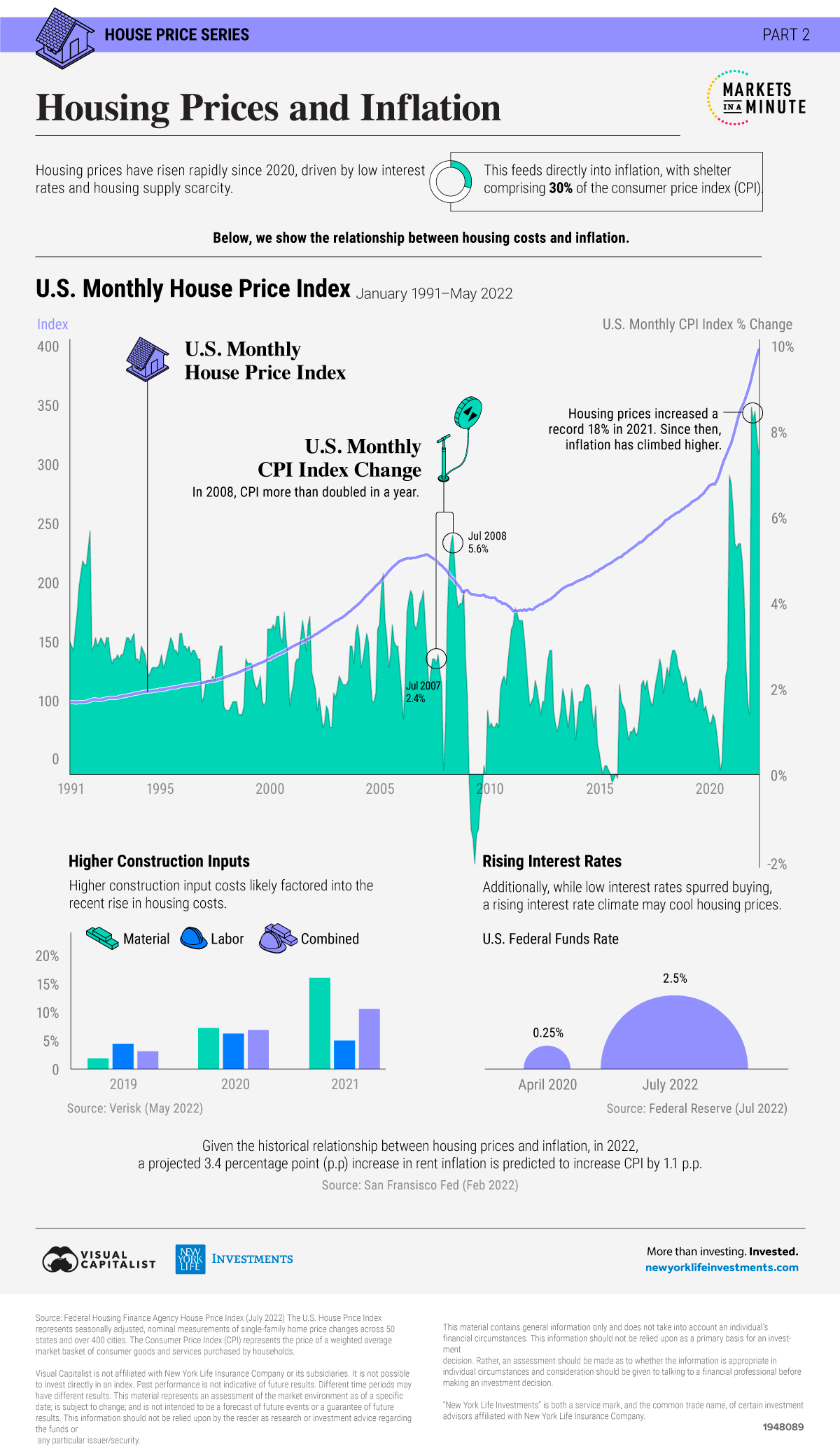
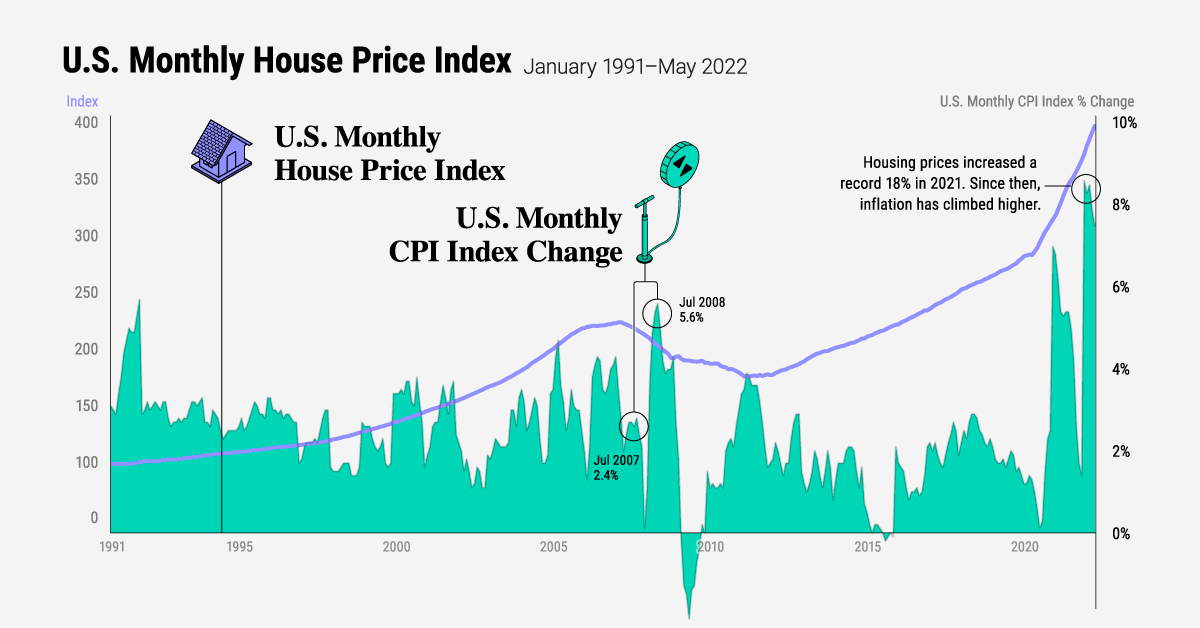

 Infographics2 years ago
Infographics2 years ago
 Markets in a Minute2 years ago
Markets in a Minute2 years ago
 Markets in a Minute2 years ago
Markets in a Minute2 years ago
 Infographics2 years ago
Infographics2 years ago
 Markets in a Minute1 year ago
Markets in a Minute1 year ago
 Infographics3 years ago
Infographics3 years ago
 Markets in a Minute2 years ago
Markets in a Minute2 years ago
 Infographics1 year ago
Infographics1 year ago








